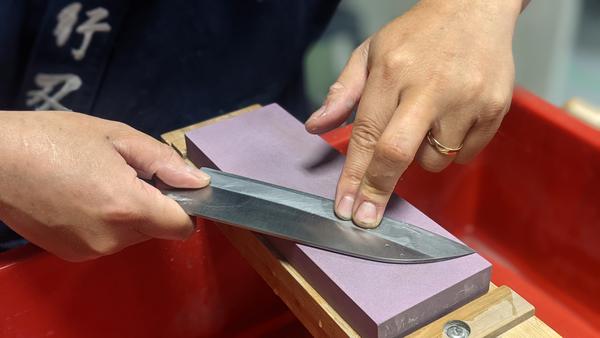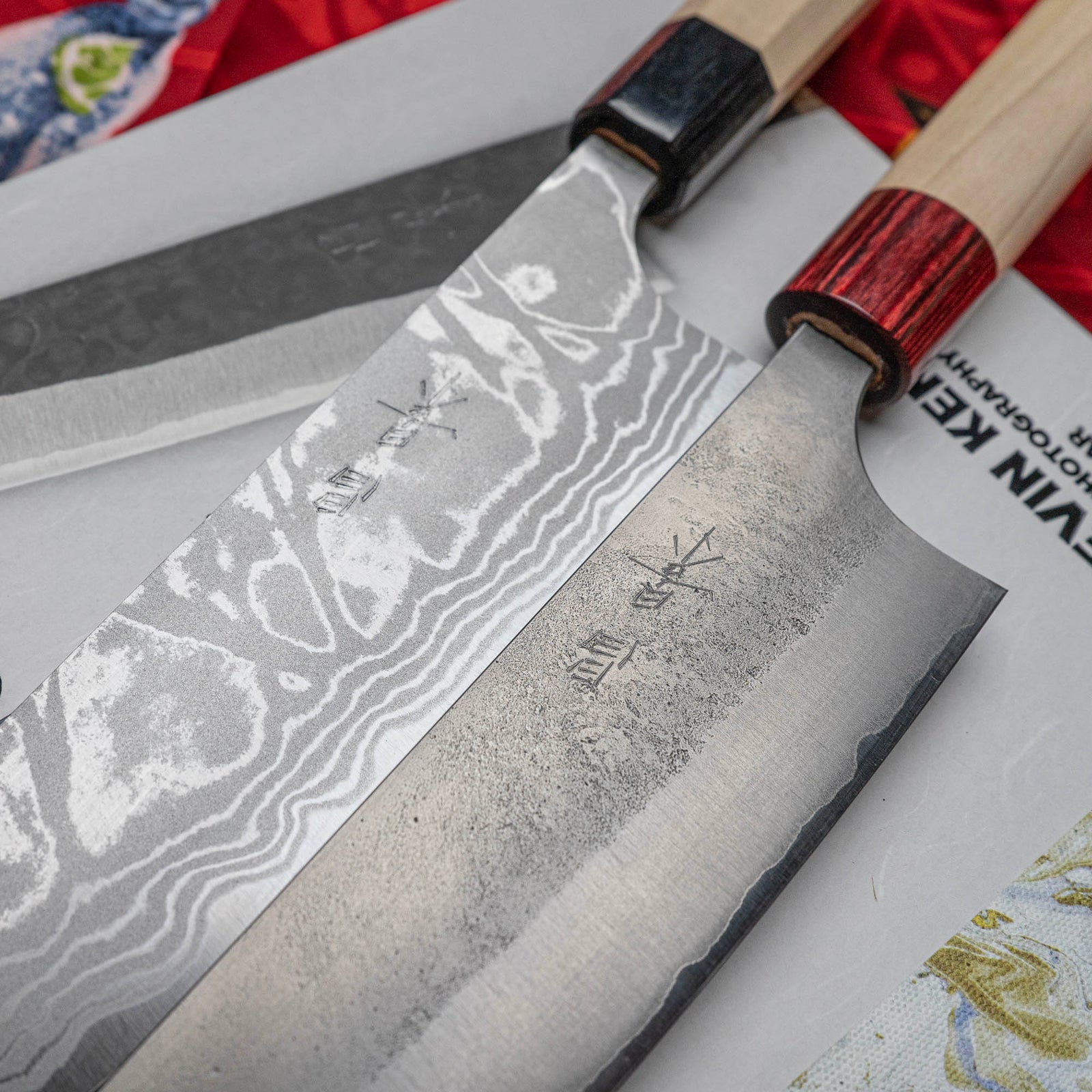Free shipping on orders over $100 - Excluding konro grills
Free shipping on orders over $100 - Excluding konro grills
Japanese Knives
Sharpening
Accessories
How to Repair a Chipped Japanese Kitchen Knife
November 30, 2021 5 min read

Did your knife hit a bone by accident? Did a family member think it was the best tool to open a coconut? Was that stalk of lemongrass just a little bit tougher than you expected?
Your beloved knife is chipped. What now?
Take a deep breath. Crack a beer, if that’s your thing. Chips happen, and we’re here to help you fix them! You can check out this video from my coworker Naoto or read on if you prefer the text version.
How to Remove a Chip from a Japanese Kitchen Knife
The first step is to get the chip(s) out. Start by marking how much steel you need to grind off with a sharpie. Since you’re going to be removing a lot of steel, you run the risk of grinding your blade unevenly, which can upset the profile of your knife. To avoid this, draw a thick line along the edge using a sharpie, up to the top of the chip.
Now, get out your coarsest stone - a Knifewear 220 grit is best, or even a diamond plate. For this first step, you’re going to hold your knife at a much wider angle than you typically would when sharpening. We’re usually aiming for 15º when working on Japanese knives, but in this case, it’s beneficial to use a 30-45º angle as it’s faster at grinding away the unwanted material. You don’t need to worry too much about keeping the knife super sharp; right now, our goal is to quickly get rid of that chip.
Now, get to grinding! You may have the impulse to use a lot of pressure (I sure do when I’m mad at a chipped knife), but gentle pressure is the key here. Let the stone do the work. Aim for about 30 strokes on each side before flipping the knife and doing the other side, repeating this process until your chip is completely gone. Be sure to grind the whole length of the blade equally to keep your profile consistent, and check your work often. Since this process is hard on your stone, try to use the whole surface of the stone evenly to reduce wear.
 With enough skill and patience, even seriously damaged knives can be fixed!
With enough skill and patience, even seriously damaged knives can be fixed!
How to Thin the Knife after Removing a Chip
At this point, your knife is going to be one chonky boi. It might still cut a little, but it’s going to feel extremely gross as it cuts, more like an axe than a knife. The grinding process will have taken away a lot of the exposed core steel along the edge, which means that super sharp edge Japanese knives are so well-known for just isn’t there anymore. To fix this issue, we thin out the knife! This is a vital part of regular knife sharpening, as well as chip repair; learning this process will majorly level up your knife-sharpening game.
Grab your 220 grit stone again, and true it thoroughly to make it flat again. This is important here because a lot of your knife’s surface will be making contact with your stone, and a flat stone ensures a consistent grind and minimal unwanted scratches.
You’re ready to go! Lay the bevel of your knife flat against the stone. The goal here is to remove some of the cladding steel along the sides to expose some of the core steel along the edge. Hold the knife in your dominant hand, and apply pressure to the bevel using your index and middle finger with your other hand. The bevel should lay flat against the stone, but try to angle it ever-so-slightly towards the edge, so the pressure is focussed there. I find applying pressure with my fingers closer to the edge helps.

Unlike sharpening, thinning is done at a low angle set by the knife's original bevel.
Start moving your knife across the stone, adjusting both the knife’s position to evenly remove steel from the sides along the entire length of the knife. Keep an eye on your cladding line, as you want to aim for an even amount of exposed core steel all along the length of the blade. I’m going to be honest: this part takes some elbow grease! Put on something from the Knifewear YouTube channel for entertainment and keep some snacks handy to keep you motivated. Keep working until you see the grinding line, or “blade road”, from the removal disappear.
When you think your knife has reached its original thinness, hone it and test it on some paper. We still have a few steps left in the process, but this is an excellent place to check your work. You’re looking for any residual chips you may have missed or spots on the blade that still feel a little thick. Don’t worry if the edge feels rough - you’ll take care of that soon!
Polishing the Bevel of Your Knife
Once you have thinned your knife adequately, it’s probably going to look a little janky. The coarse stone that did most of the work will leave a lot of scratches. To make it pretty again, repeat the previous step of holding the bevel flat on the stone, but this time use higher grits just as you would in regular sharpening (make sure to true these stones too). I find for this application, softer stones work a little better as the mud they create ensures a more even finish. You can play around with different grits, but I like to use a succession of 1000 and 2000, ending on a 4000 to polish the core steel to a higher level of shine. There’s lots of room to experiment here—you can incorporate polishing pads, fine-grit sandpaper, or chromium oxide to bring a knife’s original finish back. This process takes a little patience, but you’ll be rewarded with a beautiful knife!

Different stones will give you different finishes. From left to right: 220 grit, 1,000 grit, 4,000 grit.
Sharpen the Edge
The most satisfying part! After all that work, sharpening the edge will be a breeze, and your knife’s sharpness is going to surprise you. If you’re already familiar with sharpening Japanese knives, this part should come with few surprises.
If you’re concerned about the risk of chipping the knife again, you may opt to sharpen at a different angle than you’re used to. Whereas most Japanese kitchen knives are sharpened at 15º, adopting a 20º angle may suit you better as it’ll make for a more robust, chip-resistant edge. Following the usual routine of 1000 and 4000 (and beyond, if that’s your thing!), sharpen the edge. Be gentle here; your newly thinned knife will not need a lot of help to become wicked sharp at this point. If you want a full rundown on the sharpening process, check out this blog.
Now cut a tomato to test your freshly repaired knife. You’re welcome!
If you’d like to learn more, check out these articles, or head to our sharpening playlist on YouTube.

Subscribe
Sign up to get the latest on sales, new releases and more …




















